Stable Isotopic Evaluation of Recharge into a Karst Aquifer in a Glaciated Agricultural Region of Northeastern Wisconsin, USA
Abstract
1. Introduction
Objectives
- To demonstrate the effectiveness of community science on time-series stable isotopic tracer studies of groundwater;
- To evaluate the aquifer storage characteristics and recharge processes in a karst aquifer covered with a variable thickness of Pleistocene glacial sediments;
- To evaluate the viability of time-series stable isotope data as a supplementary method to traditional water quality indicators (e.g., coliform bacteria and nitrate) in a contamination-prone aquifer.
2. Study Area Characterization
2.1. Geology and Hydrogeology
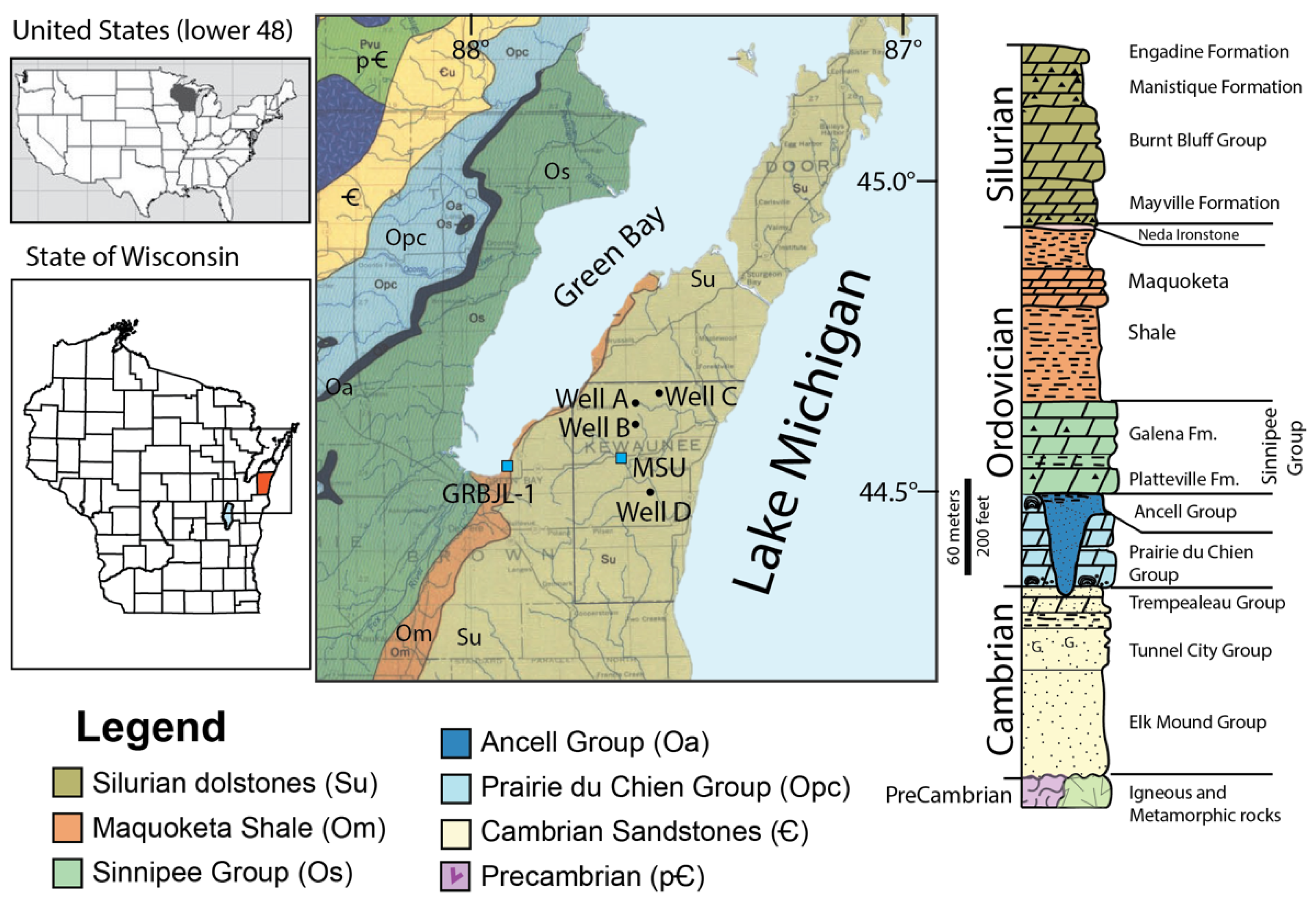
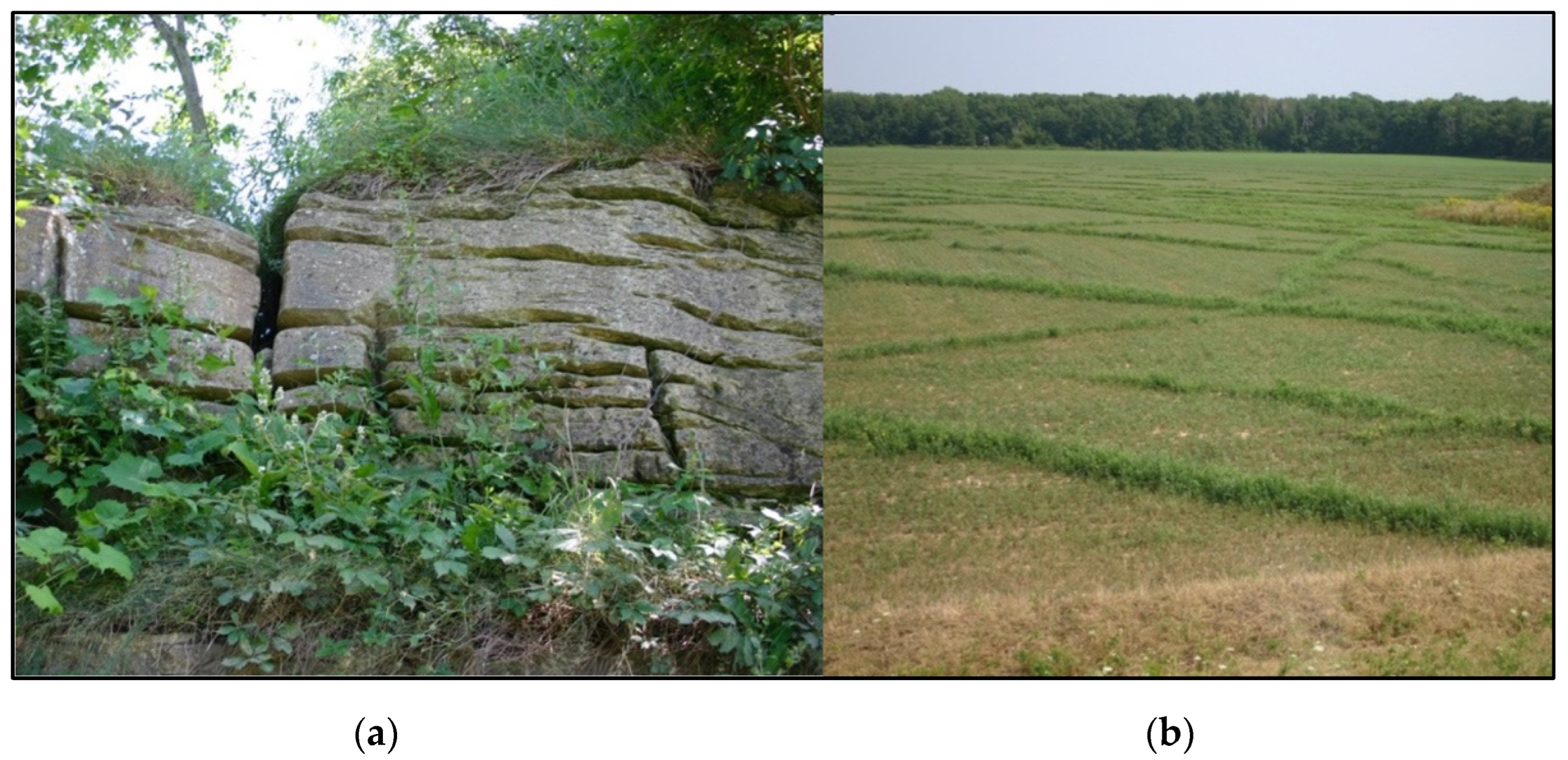
2.2. Climate and Land Use in the Groundwater Study Area
2.3. Need for a Northeastern Wisconsin Local Meteoric Water Line
3. Materials and Methods
3.1. Sample Collection for a Green Bay Local Meteoric Water Line
3.2. Well Identification and Wellhead Sampling Procedures
3.3. Laboratory Analytical Methods for Isotopic Analysis and General Chemistry
3.4. Data Pretreatment
3.5. Climatological Data for Kewaunee County
3.6. Modeling of Time-Series Data
- The pre-event groundwater signal (δ18OPEGS or δ2HPEGS, measured at the well);
- The event groundwater signal (δ18OEGS or δ2HEGS, measured at the well);
- The precipitation isotopic signal (δ18OPRECIP or δ2HPRECIP), measured at station GRBJL–1.
4. Results and Analysis
4.1. General Chemistry
4.2. A Local Meteoric Water Line for Green Bay (The Seasonal Input Signal)
4.3. Groundwater Stable Isotopic (δ18O and δ2H) Composition
4.4. Time-Series Analysis of Groundwater Stable Isotopic (δ18O and δ2H) Data
4.4.1. Long-Term Time-Series Analysis
4.4.2. Short-Term Event-Response Analysis
- Spring 2015: Events #1–3
- Summer 2015: Events #4–6
- Fall 2015: Events #7–8
- Winter 2015 and early 2016: Events #9–10 and subsequent events
5. Discussion
6. Conclusions
Supplementary Materials
Author Contributions
Funding
Data Availability Statement
Acknowledgments
Conflicts of Interest
References
- Ford, D.; Williams, P. Karst Hydrogeology and Geomorphology, 2nd ed.; John Wiley & Sons Ltd.: West Sussex, UK, 2007; pp. 1–562. [Google Scholar]
- Lakey, B.; Krothe, N.C. Stable isotopic variation of storm discharge from a perennial karst spring, Indiana. Water Resour. Res. 1996, 32, 721–731. [Google Scholar] [CrossRef]
- Zachariasen, G. Caves and karst of the Niagara Escarpment: A caver’s perspective. Geosci. Wis. 2016, 22, 1–9. Available online: https://wgnhs.wisc.edu/pubshare/GS22-a05.pdf (accessed on 16 April 2023).
- Sappa, G.; Vitale, S.; Ferranti, F. Identifying Karst Aquifer Recharge Areas using Environmental Isotopes: A Case Study in Central Italy. Geosciences 2018, 8, 351. [Google Scholar] [CrossRef]
- Iacurto, S.; Grelle, G.; De Filippi, F.M.; Sappa, G. Karst Recharge Areas Identified by Combined Application of Isotopes and Hydrogeological Budget. Water 2021, 13, 1965. [Google Scholar] [CrossRef]
- Mahindawansha, A.; Jost, M.; Gassmann, M. Spatial and Temporal Variations of Stable Isotopes in Precipitation in the Mountainous Region, North Hesse. Water 2022, 14, 3910. [Google Scholar] [CrossRef]
- Cane, G.; Clark, I.D. Tracing Ground Water Recharge in and Agricultural Watershed with Isotopes. Ground Water 1999, 37, 133–139. [Google Scholar] [CrossRef]
- Doctor, D.H.; Alexander, E.C., Jr.; Petrič, M.; Kogovšek, J.; Urbanc, J.; Lojen, S.; Stichler, W. Quantification of karst aquifer discharge components during storm events through end-member mixing analysis using natural chemistry and stable isotopes as tracers. Hydrogeol. J. 2006, 14, 1171–1191. [Google Scholar] [CrossRef]
- Petitta, M.; Scarascia-Mugnozza, G.; Barbieri, M.; Bianchi-Fasani, G.; Esposito, C. Hydrodynamic and isotopic investigations for evaluating the mechanisms and amount of groundwater seepage through a rockslide dam. Hydrol. Process. 2010, 24, 3510–3520. [Google Scholar] [CrossRef]
- Petrella, E.; Celico, F. Mixing of water in a carbonate aquifer, southern Italy, analyzed through stable isotope investigations. Int. J. Speleol. 2013, 42, 25–33. [Google Scholar] [CrossRef]
- Delbart, C.; Barbecot, F.; Valdes, D.; Tognelli, A.; Fourre, E.; Purtschert, R.; Couchoux, L.; Jean-Baptiste, P. Investigation of young water inflow in karst aquifers using SF6-CFC-3H/He-85Kr-39Ar and stable isotope components. Appl. Geochem. 2014, 50, 164–176. [Google Scholar] [CrossRef]
- Kanduč, T.; Grassa, F.; McIntosh, J.; Stibilj, V.; Ulrich-Supovec, M.; Supovec, I.; Jamnikar, S. A Geochemical and stable isotope investigation of groundwater/surface-water interactions in the Velenje Basin, Slovenia. Hydrogeol. J. 2014, 22, 971–984. [Google Scholar] [CrossRef]
- Palcsu, L.; Gessert, A.; Túri, M.; Kovács, A.; Futó, I.; Orsovszki, J.; Puskás-Preszner, A.; Temovski, M.; Koltai, G. Long-term time series of environmental tracers reveal recharge and discharge conditions in shallow karst aquifers in Hungary and Slovakia. J. Hydrol. Reg. Stud. 2021, 36, 100858. [Google Scholar] [CrossRef]
- Mance, D.; Radišić, M.; Lenac, D.; Rubinić, J. Hydrological Behavior of Karst Systems Identified by Statistical Analyses of Stable Isotope Monitoring Results. Hydrology 2022, 9, 82. [Google Scholar] [CrossRef]
- Maloszewski, P.; Stichler, W.; Zuber, A.; Rank, D. Identifying the flow systems in a karstic-fissured-porous aquifer, the Schneealpe, Austria, by modelling of environmental 18O and 3H isotopes. J. Hydrol. 2002, 256, 48–59. [Google Scholar] [CrossRef]
- Schwarz, K.; Barth, J.A.C.; Postigo-Rebollo, C.; Grathwohl, P. Mixing and transport of water in a karst catchment: A case study from precipitation via seepage to the spring. Hydrol. Earth Syst. Sci. 2009, 12, 285–292. [Google Scholar] [CrossRef]
- Hu, Y.; Liu, Z.; Ford, D.; Zhao, M.; Bao, Q.; Zeng, C.; Gong, X.; Wei, Y.; Cai, X.; Chen, J. Conservation of oxygen and hydrogen seasonal isotopic signals in meteoric precipitation in groundwater: An experimental tank study of the effects of land cover in a summer monsoon climate. Geochim. Cosmochim. Acta 2020, 284, 254–272. [Google Scholar] [CrossRef]
- Njue, N.; Kroese, J.S.; Gräf, J.; Jacobs, S.R.; Weeser, B.; Breuer, L.; Rufino, M.C. Citizen science in hydrological monitoring and ecosystem services management: State of the art and future prospects. Sci. Total Environ. 2019, 693, 133531. [Google Scholar] [CrossRef]
- Harris, C. World’s Largest Freshwater Citizen Science Project Set to Tap into Groundwater Quality. Australian Water Association (1 December 2022). Available online: https://www.awa.asn.au/resources/latest-news/worlds-largest-freshwater-citizen-science-project-set-to-tap-into-groundwater-quality (accessed on 26 February 2023).
- Muldoon, M.A.; Simo, J.A.; Bradbury, K.R. Correlation of hydraulic conductivity with stratigraphy in a fractured-dolomite aquifer, northeastern Wisconsin, USA. Hydrogeol. J. 2001, 9, 570–583. Available online: https://link.springer.com/content/pdf/10.1007/s10040-001-0165-5.pdf (accessed on 16 April 2023).
- Luczaj, J.A. Geology of the Niagara escarpment in Wisconsin. Geosci. Wis. 2013, 22, 1–34. Available online: http://wgnhs.uwex.edu/pubs/gs22a01/ (accessed on 28 January 2022).
- Rayne, T.W.; Bradbury, K.R.; Muldoon, M.A. Delineation of capture zones for municipal wells in fractured dolomite, Sturgeon Bay, Wisconsin, USA. Hydrogeol. J. 2001, 9, 432–450. [Google Scholar] [CrossRef]
- Bradbury, K.R. Door County’s groundwater: An asset or a liability? In Proceedings Conference on Door County and the Niagara Escarpment: Foundations for the Future; Hershbell, K., Ed.; Wisconsin Academy of Sciences, Arts, and Letters: Madison, WI, USA, 1989; pp. 36–44. [Google Scholar]
- Parsen, M.J.; Mauel, S.W.; Streiff, C.M. Hydrogeological characterization of the Town of Lincoln, Kewaunee County, Wisconsin. WGNHS Open File Rep. 2017, 2017-05, 33p, Plus Maps and Appendices. Available online: https://wgnhs.wisc.edu/pubshare/WOFR2017-05.pdf (accessed on 6 April 2023).
- Muldoon, M.A.; Borchardt, M.A.; Spencer, S.K.; Hunt, R.J.; Owens, D. Using Enteric Pathogens to Assess Sources of Fecal Contamination in the Silurian Dolomite Aquifer: Preliminary Results. In Karst Groundwater Contamination and Public Health, Advances in Karst Science; White, W., Herman, J., Herman, E., Rutigliano, M., Eds.; Springer: Cham, Switzerland, 2018; pp. 209–213. [Google Scholar] [CrossRef]
- Owens, D.W.; Hunt, R.J.; Firnstahl, A.D.; Muldoon, M.A.; Borchardt, M.A. Automated Time Series Measurement of Microbial Concentrations in Groundwater -Derived Water Supplies. Groundwater 2019, 57, 329–336. [Google Scholar] [CrossRef]
- Mudrey, M.G., Jr.; Brown, B.A.; Greenberg, J.K. Bedrock Geologic Map of Wisconsin; University of Wisconsin-Extension, Geological and Natural History Survey: Madison, WI, USA, 1982; scale = 1:1,000,000. [Google Scholar]
- Luczaj, J.A.; Maas, J.; Hart, D.J.; Odekirk, J. Aquifer Drawdown and Recovery in the Northeast Groundwater Management Area, Wisconsin, USA: A Century of Groundwater Use. Geosciences 2017, 7, 11. [Google Scholar] [CrossRef]
- Erb, K.R.; Stieglitz, R. Final Report of the Northeast Wisconsin Karst Task Force; University of Wisconsin—Extension: Madison, WI, USA, 2007; pp. 1–46. [Google Scholar]
- Borchardt, M.A.; Bradbury, K.R.; Alexander, E.C., Jr.; Kolberg, R.J.; Alexander, S.C.; Archer, J.R.; Braatz, L.A.; Forest, B.M.; Green, J.A.; Spencer, S.K. Norovirus outbreak caused by a new septic system in a dolomite aquifer. Ground Water 2011, 49, 85–97. [Google Scholar] [CrossRef]
- Bauer, A.C.; Wingert, S.; Fermanich, K.J.; Zorn, M.E. Well water in karst regions of northeastern Wisconsin contains estrogenic factors, nitrate, and bacteria. Water Environ. Res. 2013, 85, 318–326. [Google Scholar] [CrossRef]
- Bonness, D.; Masarik, K. Investigating Intra-Annual Variability of Well Water Quality in Lincoln Township; Final Report; June 2014; pp. 1–42. Available online: http://www.uwsp.edu/cnr-ap/watershed/Documents/Lincoln_FinalReport.pdf (accessed on 28 January 2022).
- Erb, K.; Ronk, E.; Koundinya, V.; Luczaj, J.A. Groundwater Quality Changes in a Karst Aquifer of Northeastern Wisconsin, USA: Reduction of Brown Water Incidence and Bacterial Contamination Resulting from Implementation of Regional Task Force Recommendations. Resources 2015, 4, 655–672. [Google Scholar] [CrossRef]
- Luczaj, J.A.; Masarik, K. Groundwater Quantity and Quality Issues in a Water-Rich Region: Examples from Wisconsin, USA. Resources 2015, 4, 323–357. [Google Scholar] [CrossRef]
- Borchardt, M.A.; Stokdyk, J.P.; Kieke, B.A., Jr.; Muldoon, M.A.; Spencer, S.K.; Firnstahl, A.D.; Bonness, D.E.; Hunt, R.J.; Burch, T.R. Sources and Risk Factors for Nitrate and Microbial Contamination of Private Household Wells in the Fractured Dolomite Aquifer of Northeastern Wisconsin. Environ. Health Perspect. 2021, 129, 067004. [Google Scholar] [CrossRef]
- Burch, T.R.; Stokdyk, J.P.; Spencer, S.K.; Kieke, B.A., Jr.; Firnstahl, A.D.; Muldoon, M.A.; Borchardt, M.A. Quantitative Microbial Risk Assessment for Contaminated Private Wells in the Fractured Dolomite Aquifer of Kewaunee County, Wisconsin. Environ. Health Perspect. 2021, 129, 067003. [Google Scholar] [CrossRef]
- Nicole, W. Farm to Faucet? Agricultural Waste and Private Well Contamination in Kewaunee County, Wisconsin. Environ. Health Perspect. 2021, 129, 114001. [Google Scholar] [CrossRef]
- National Centers for Environmental Information—National Oceanic and Atmospheric Administration. Data Search—National Centers for Environmental Information (NCEI). Available online: https://www.ncei.noaa.gov/access/search/data-search/normals-annualseasonal-2006-2020 (accessed on 5 April 2023).
- Vachon, R.W.; White, J.W.C.; Gutmann, E.; Welker, J.M. Amount-weighted annual isotopic (δ18O) values are affected by the seasonality of precipitation: A sensitivity study. Geophys. Res. Lett. 2007, 34, L21707. [Google Scholar] [CrossRef]
- Swanson, S.K.; Bahr, J.M.; Potter, K.W. A Local Meteoric Water Line for Madison, Wisconsin. Wis. Geol. Nat. Hist. Surv. Open-File Rep. 2006, 2006-01, 4p. [Google Scholar]
- Michigan State University Enviroweather. Casco/Luxemburg, WI—MSU Enviroweather. Available online: https://legacy.enviroweather.msu.edu/weather.php?stn=lux (accessed on 4 April 2023).
- Midwest Regional Climate Center. Cli-MATE Daily-Observed Station Selector. Available online: https://mrcc.purdue.edu/CLIMATE/ (accessed on 4 April 2023).
- National Centers for Environmental Information—National Oceanic and Atmospheric Administration. Daily U.S. Snowfall and Snow Depth. Available online: https://www.ncei.noaa.gov/access/monitoring/daily-snow/WI/snowfall (accessed on 5 April 2023).
- University of Wisconsin—Extension AgWeather. National Weather Service Co-Op Observer Reports Database. Available online: https://agweather.cals.wisc.edu/weather/hyd (accessed on 8 April 2023).
- Craig, H. Isotopic variations in meteoric waters. Science 1961, 133, 1702–1703. [Google Scholar] [CrossRef] [PubMed]
- Bowen, G.J.; Kennedy, C.D.; Henne, P.D.; Zhang, T. Footprint of recycled water subsidies downwind of Lake Michigan. Ecosphere 2012, 3, 53. [Google Scholar] [CrossRef]
- Kunze, T.; Luczaj, J. A Regional Groundwater Isoscape for δ2H and δ18O in the Silurian Aquifer of Northeastern Wisconsin. In Proceedings of the American Water Resources Association—Wisconsin Section Conference, Online, 4 March 2021. [Google Scholar]
- Clark, I.D.; Fritz, P. Environmental Isotopes in Hydrogeology; Lewis Publishers: New York, NY, USA, 1997; Volume 2097, 328p, ISBN 9781566702492. [Google Scholar]
- Jasechko, S.; Gibson, J.J.; Edwards, T.W.D. Stable isotope mass balance of the Laurentian Great Lakes. J. Great Lakes Res. 2014, 40, 336–346. [Google Scholar] [CrossRef]
- Luczaj, J.A.; Houghton, C.J.; Shea, A.W. A Depth-to-Bedrock Map and Deep Aquifer Characterization for Kewaunee County, Wisconsin. In Final Grant Report Submitted to the Wisconsin Department of Natural Resources; Wisconsin Geological and Natural History Survey: Mt Horeb, WI, USA, 2019; 35p. [Google Scholar]
- National Oceanic and Atmospheric Administration—National Weather Service. Cold and Snowy Winter of 2013–2014. Available online: https://www.weather.gov/grb/winter2013-14cold#:~:text=What%20made%20the%20winter%20of,days%20set%20in%201916%2D17 (accessed on 28 March 2023).
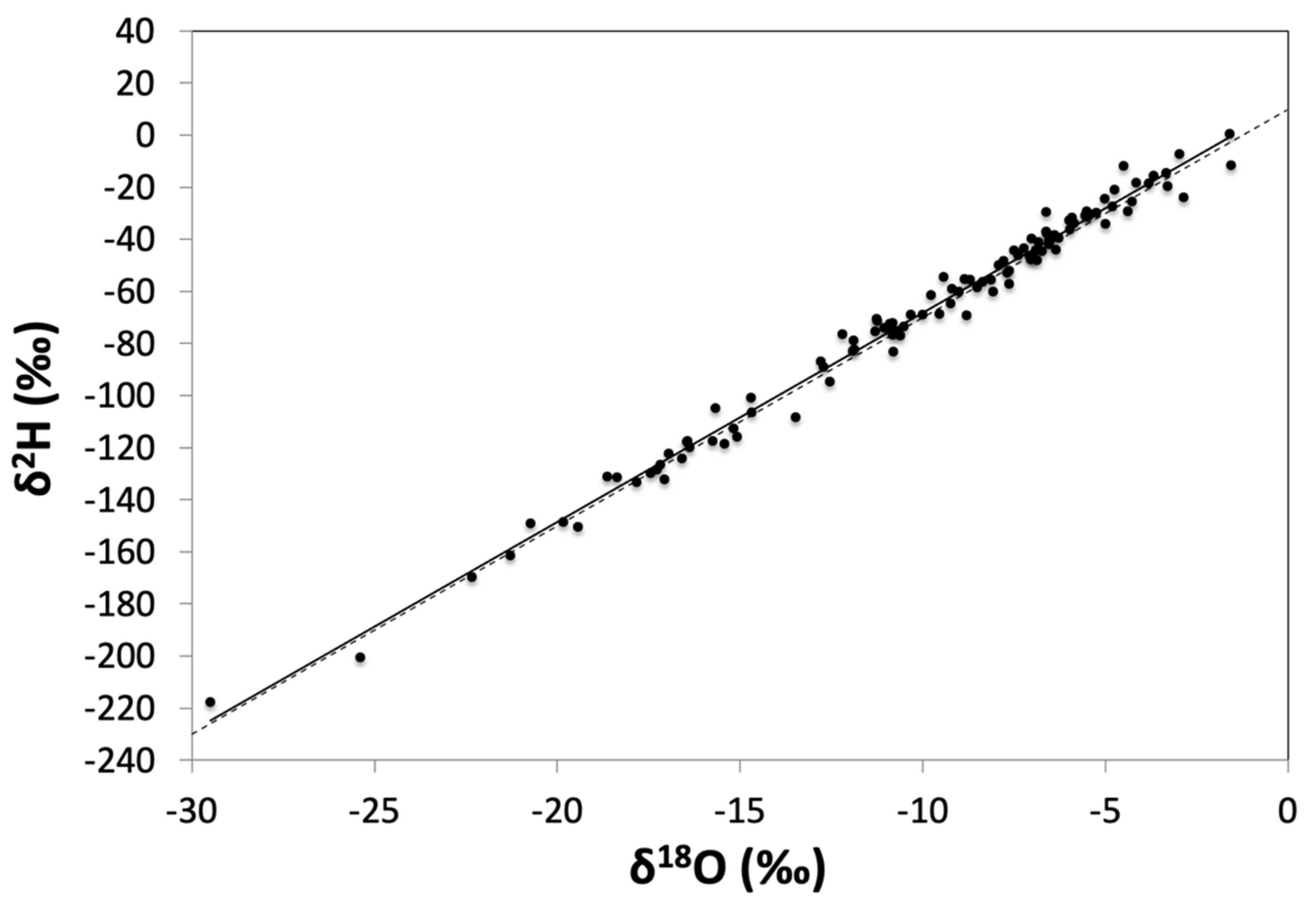
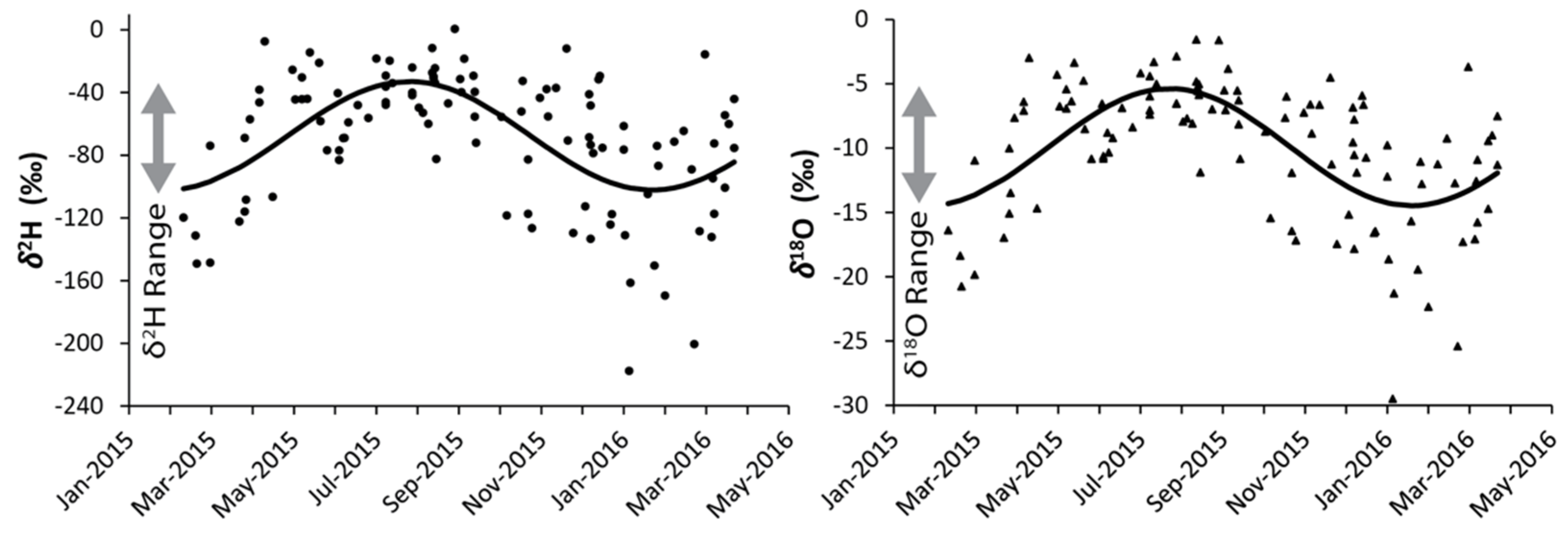

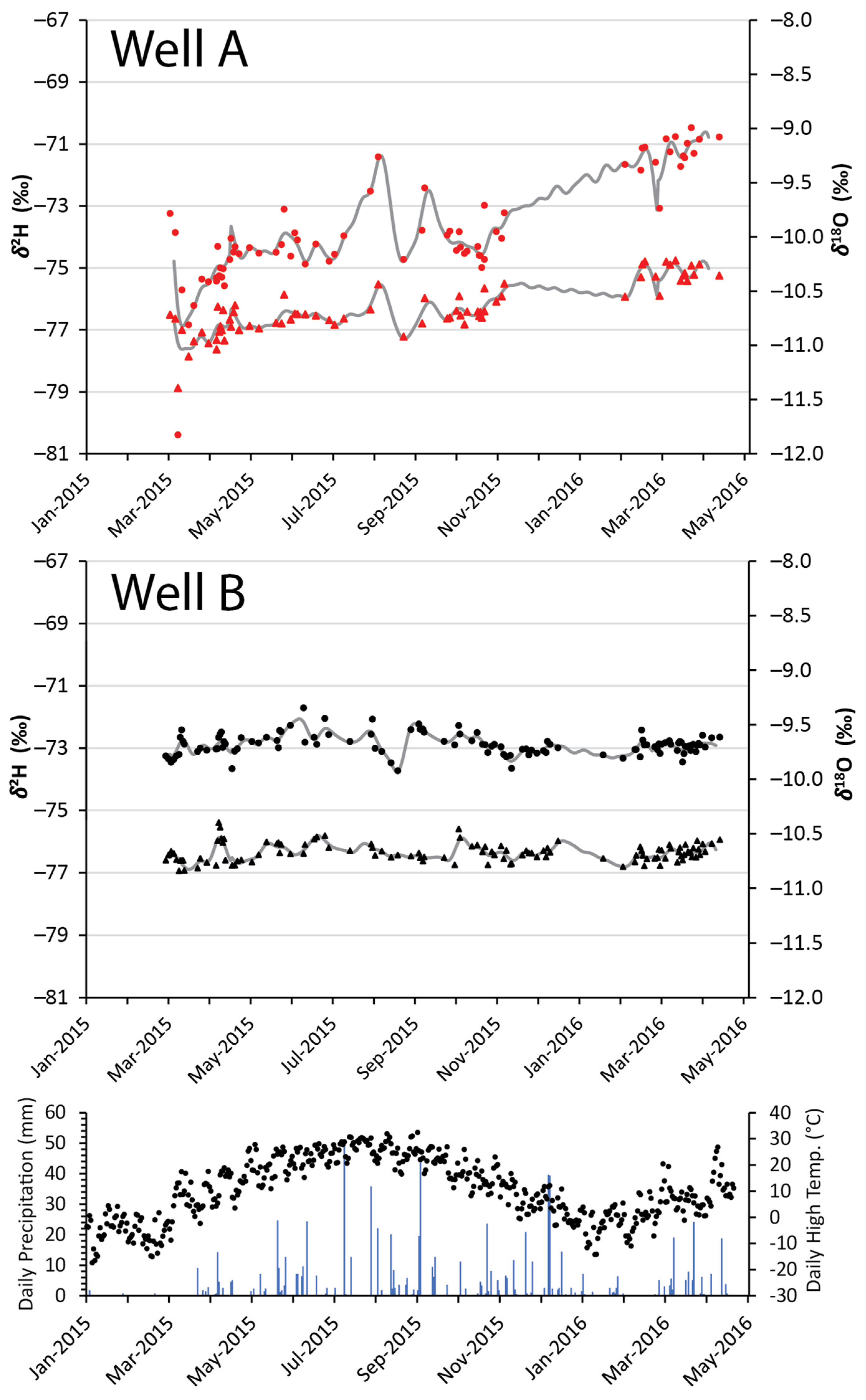
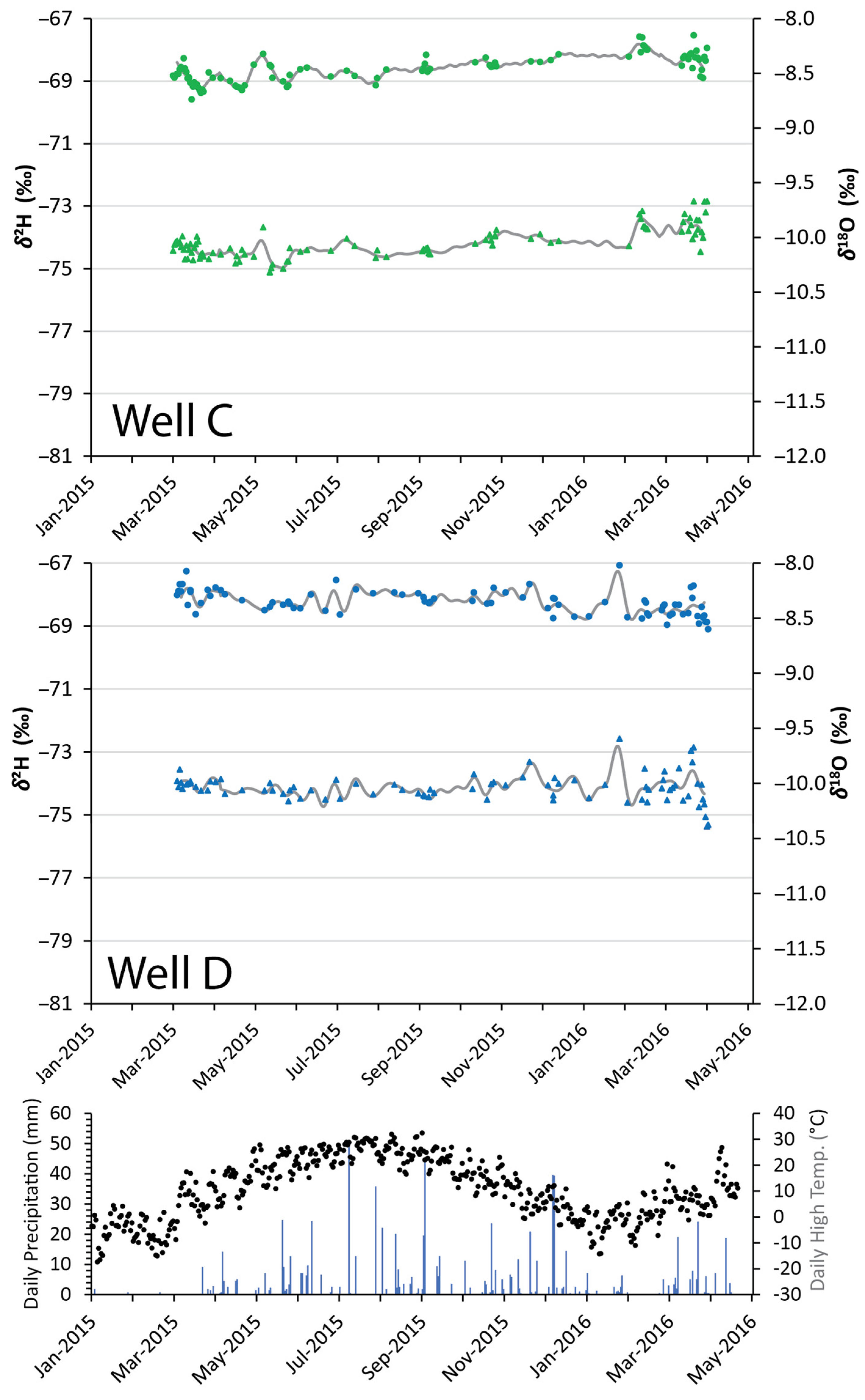

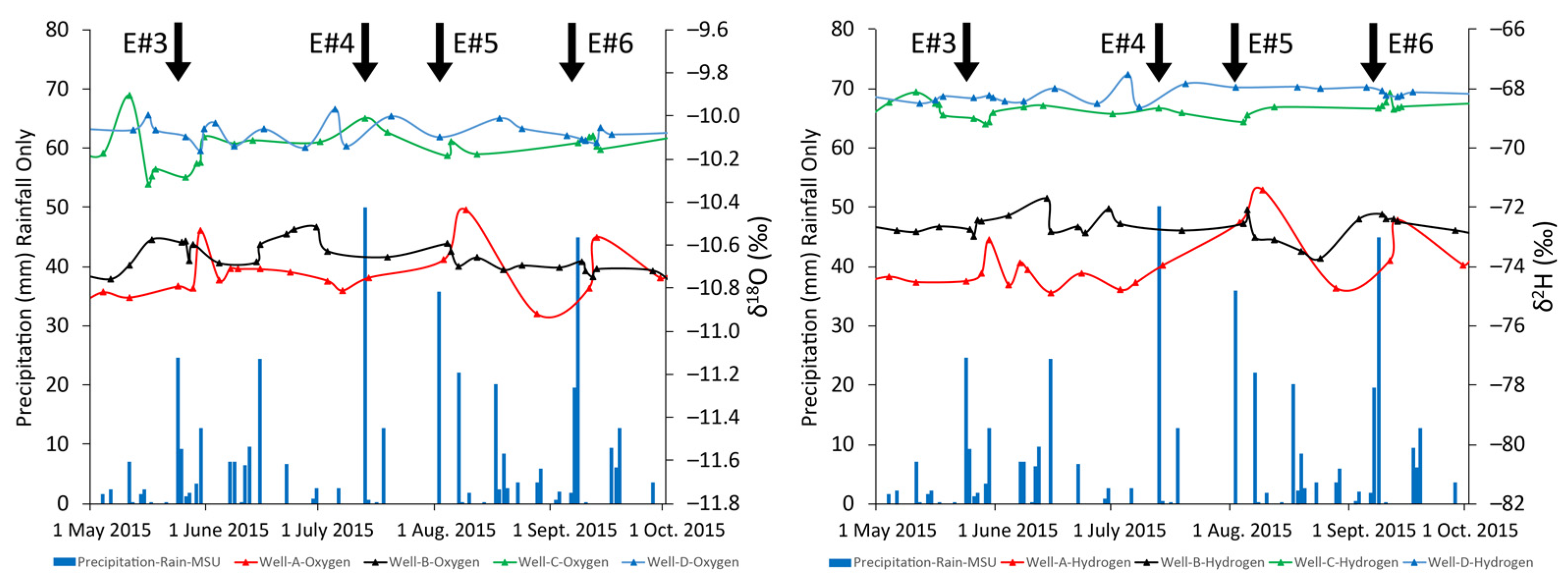

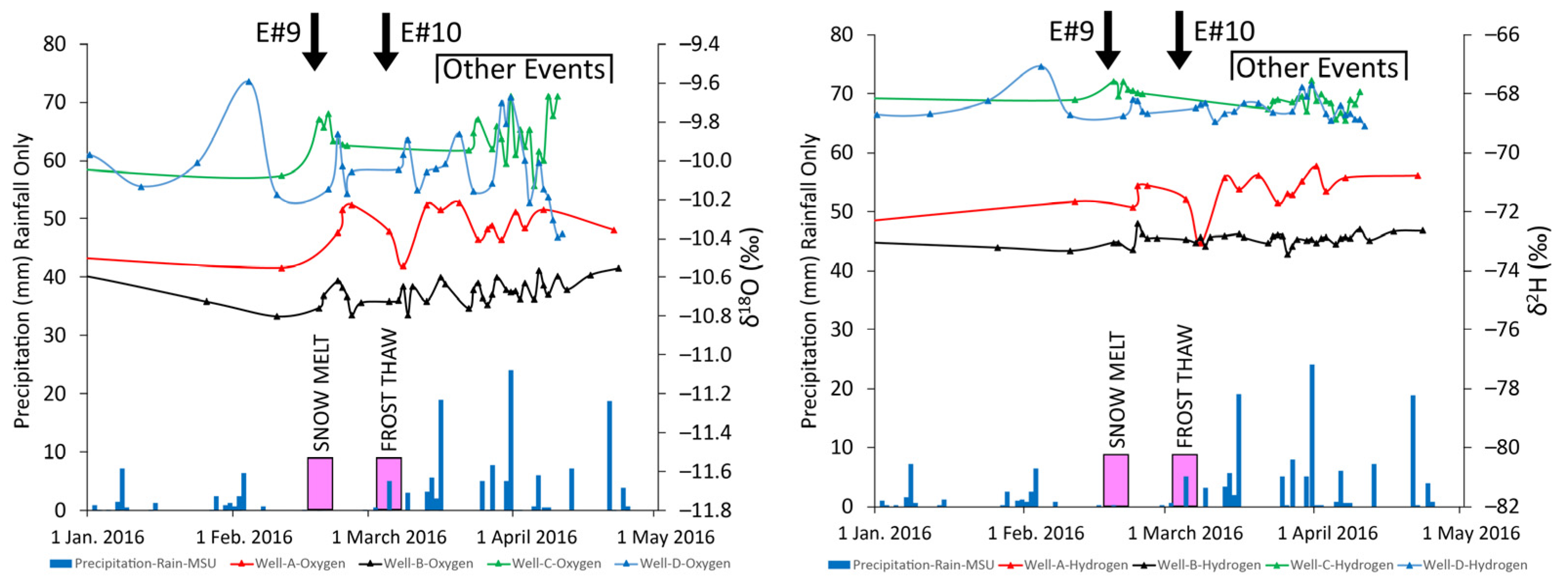
| Well | Land Surface Elevation (m) | Total Well Depth | Casing Depth | Depth to Bedrock from Well Records | Depth to Water (Day of Drilling) |
|---|---|---|---|---|---|
| A | 238 | 22.5 | 1.5 | 3.0 * | 1.22 |
| B | 239 | 43.2 | 13.1 | 12.8 | 18.3 |
| C | 229 | 73.2 | 18.3 | 2.4 | 27.4 |
| D | 219 | 110.9 | 24.1 | 24.1 | 16.8 |
| Well | pH | Cond. | Ca | Mg | Na | K | Sr | Cl | SO4 | F | NO3-N | Alk. |
|---|---|---|---|---|---|---|---|---|---|---|---|---|
| A | 7.49 | 815 | 86.3 | 41.5 | 22.0 | 1.39 | 0.0462 | 32.1 | 12.2 | <0.20 | 4.9 | 358 |
| B | - | - | 115.0 | 55.7 | 12.2 | 3.54 | 0.0803 | 59.6 | 30.5 | <0.20 | 23.1 | 357 |
| C | 7.57 | 739 | 87.0 | 43.3 | 5.55 | 2.21 | 0.0588 | 17.3 | 28.7 | <0.20 | 14.0 | 288 |
| D | - | - | 54.2 | 47.4 | 8.08 | 1.99 | 0.4380 | 8.2 | 25.4 | 0.23 * | <0.15 | 310 |
| Dataset | m | b | R2 | n |
|---|---|---|---|---|
| All samples in Table S1 | 8.029 | 12.05 | 0.9877 | 111 |
| Subsets of Data | ||||
| Water Year A (12 months) (1 March 2015–28 February 2016) | 7.976 | 11.45 | 0.9864 | 96 |
| Water Year B (12 months) (1 April 2015–31 March 2016) | 8.033 | 12.17 | 0.9872 | 102 |
| Historical Data | ||||
| Madison, Wisconsin (1998–1999) 1 | 7.79 | 13.1 | 0.986 | 10 |
| Global MWL 2 | 8 | 10 | 400 |
| Well | Event Type * | Percent Recharge (δ18O) | Percent Recharge (δ2H) | Percent Recharge (Average) |
|---|---|---|---|---|
| Well A | ||||
| Event #1 | Snow melt | 11.6% | 15.1% | 13.3% |
| Event #2 | Rain | 10.9% | 3.3% | 7.1% |
| Event #3 | Rain | 4.7% | 2.8% | 3.8% |
| Event #4 | Rain | 2.1% | 4.8% | 3.4% |
| Event #5 | Rain | 6.5% | 4.0% | 5.2% |
| Event #6 | Rain | 8.1% | 6.1% | 7.1% |
| Event #7 | Rain 1 | 2.4% | 2.2% | 2.3% |
| Event #8 | Rain | x | x | x |
| Event #9 | Snow melt 1,2 | Response 2 | Response 2 | Response 2 |
| Event #10 | Frost thaw, Snow | 6.0% | 4.9% | 5.5% |
| Well B | ||||
| Event #1 | Snow melt | 3.0% | 0% | <2% |
| Event #2 | Rain | 9.6% | 1.7% | 5.7% |
| Event #3 | Rain | ns | 0.7% | <1% |
| Event #4 | Rain | 1.5% | 2.5% | 2.0% |
| Event #5 | Rain | ns | ns | ns |
| Event #6 | Rain | 0.4% | 4.0% | 2.2% |
| Event #7 | Rain 1 | 3.6% | 1.7% | 2.6% |
| Event #8 | Rain | 3.6% | 1.5% | 2.5% |
| Event #9 | Snow melt 1,2 | Response 2 | Response 2 | Response 2 |
| Event #10 | Frost thaw, Snow | 1.4% | 0.7% | 1.1% |
| Well C | ||||
| Event #1 | Snow melt | 2.5% | 1.5% | 2.0% |
| Event #2 | Rain | 1.6% | 0% | ns |
| Event #3 | Rain | 3.7% | 0.5% | 2.1% |
| Event #4 | Rain | ns | ns | ns 1 |
| Event #5 | Rain | 2.2% | 2.1% | 2.1% |
| Event #6 | Rain | 2.0% | 1.3% | 1.6% |
| Event #7 | Rain 1 | 1.8% | 0.7% | 1.2% |
| Event #8 | Rain | 6.0% | 1.6% | 3.8% |
| Event #9 | Snow melt 1,2 | Response 2 | Response 2 | Response 2 |
| Event #10 | Frost thaw, Snow | ns | ns | ns |
| Well D | ||||
| Event #1 | Snow melt | 0.8% | 0.6% | 0.7% |
| Event #2 | Rain | ns | ns | ns 1 |
| Event #3 | Rain | 1.2% | ns | <0.6% |
| Event #4 | Rain | 4.0% | 3.2% | 3.6% |
| Event #5 | Rain | 2.9% | 0.1% | 1.5% |
| Event #6 | Rain | 1.0% | ns 1 | <0.5% |
| Event #7 | Rain 1 | Response 2 | Response 2 | Response 2 |
| Event #8 | Rain | 7.3% | 2.0% | 4.7% |
| Event #9 | Snow melt 1,2 | Response 2 | Response 2 | Response 2 |
| Event #10 | Frost thaw, Snow | 2.0% | 0.7% | 1.3% |
Disclaimer/Publisher’s Note: The statements, opinions and data contained in all publications are solely those of the individual author(s) and contributor(s) and not of MDPI and/or the editor(s). MDPI and/or the editor(s) disclaim responsibility for any injury to people or property resulting from any ideas, methods, instructions or products referred to in the content. |
© 2023 by the authors. Licensee MDPI, Basel, Switzerland. This article is an open access article distributed under the terms and conditions of the Creative Commons Attribution (CC BY) license (https://creativecommons.org/licenses/by/4.0/).
Share and Cite
Luczaj, J.A.; Konrad, A.; Norfleet, M.; Schauer, A. Stable Isotopic Evaluation of Recharge into a Karst Aquifer in a Glaciated Agricultural Region of Northeastern Wisconsin, USA. Hydrology 2023, 10, 133. https://doi.org/10.3390/hydrology10060133
Luczaj JA, Konrad A, Norfleet M, Schauer A. Stable Isotopic Evaluation of Recharge into a Karst Aquifer in a Glaciated Agricultural Region of Northeastern Wisconsin, USA. Hydrology. 2023; 10(6):133. https://doi.org/10.3390/hydrology10060133
Chicago/Turabian StyleLuczaj, John A., Amber Konrad, Mark Norfleet, and Andrew Schauer. 2023. "Stable Isotopic Evaluation of Recharge into a Karst Aquifer in a Glaciated Agricultural Region of Northeastern Wisconsin, USA" Hydrology 10, no. 6: 133. https://doi.org/10.3390/hydrology10060133
APA StyleLuczaj, J. A., Konrad, A., Norfleet, M., & Schauer, A. (2023). Stable Isotopic Evaluation of Recharge into a Karst Aquifer in a Glaciated Agricultural Region of Northeastern Wisconsin, USA. Hydrology, 10(6), 133. https://doi.org/10.3390/hydrology10060133






